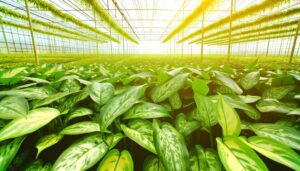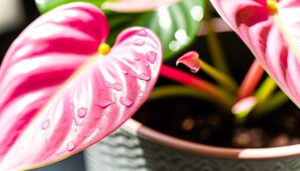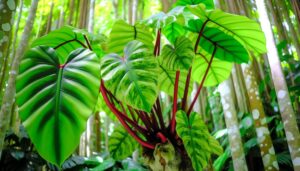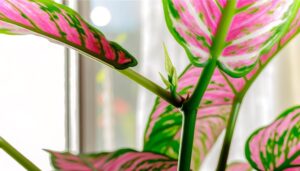Why Does My Philodendron Birkin Have Yellow Leaves?
Yellow leaves on a Philodendron Birkin may indicate overwatering or underwatering, which disrupt root function and nutrient uptake. Poor lighting can reduce chlorophyll synthesis, while temperature stress from drafts or excessive heat similarly impacts physiological processes.
Nutrient deficiencies impair photosynthesis and cause chlorosis. Pests, such as spider mites and aphids, damage leaf tissue, disrupting nutrient transport.
Natural aging also leads to gradual yellowing due to nutrient reallocation governed by phytohormones. Understanding these factors is indispensable for maintaining plant health and ensuring robust growth.
By addressing these issues, you can better support the vitality of your Philodendron Birkin.
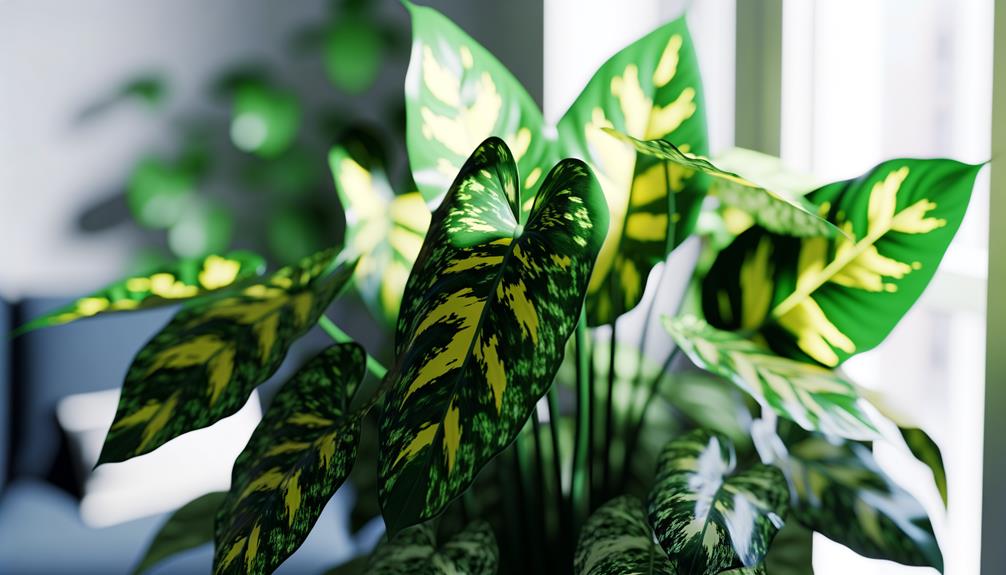
Key Takeaways
- Overwatering creates anaerobic soil conditions, leading to root rot and yellowing leaves.
- Poor lighting hinders photosynthesis and chlorophyll synthesis, causing yellow leaves.
- Temperature stress from cold drafts or excessive heat can induce leaf yellowing.
- Nutrient deficiency impedes chlorophyll production, resulting in yellow leaves.
- Pest infestations disrupt nutrient and water transport, leading to chlorosis and yellow leaves.
Overwatering
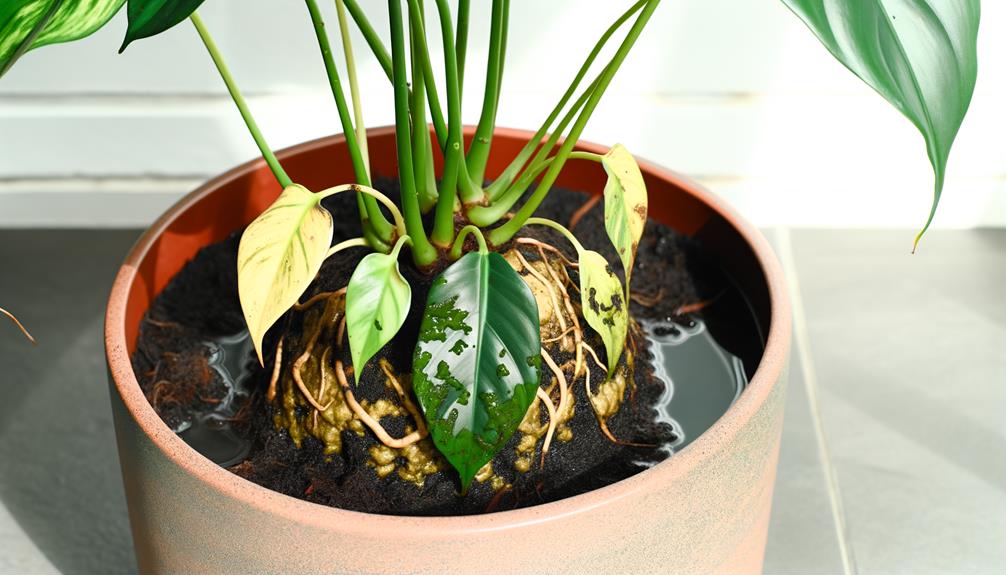
Why does overwatering lead to yellow leaves in Philodendron Birkin?
Overwatering creates an anaerobic environment in the soil, promoting root hypoxia and subsequent root rot. Philodendron Birkin roots require adequate oxygen for cellular respiration and nutrient uptake.
Excess water displaces air pockets in the soil, impairing gas exchange and leading to root asphyxiation. This condition hinders the roots' ability to absorb essential nutrients, particularly nitrogen, which is vital for chlorophyll synthesis.
As a result, chlorosis manifests, characterized by yellowing leaves due to insufficient chlorophyll. Additionally, prolonged water saturation encourages pathogenic fungi, such as Pythium and Phytophthora, exacerbating root decay.
Thus, maintaining peak watering practices is essential to prevent yellow leaves and guarantee the plant's overall health.
Underwatering
Underwatering can result in an inconsistent watering schedule, leading to physiological stress in Philodendron Birkin. This plant exhibits signs of dehydration, such as yellowing leaves, wilting, and a loss of turgor pressure.
These symptoms occur due to insufficient water uptake, impairing cellular function and metabolic processes.
Inconsistent Watering Schedule
An inconsistent watering schedule, particularly periods of underwatering, can disrupt the physiological balance of Philodendron Birkin, leading to yellowing leaves as a primary symptom of hydric stress.
When water availability fluctuates, the plant's vascular system experiences irregularities in nutrient uptake and transport. Insufficient hydration hinders the photosynthetic capacity, causing chlorophyll degradation and subsequent chlorosis.
The root system, deprived of adequate moisture, undergoes cellular desiccation, impairing its functional integrity. As a result, the plant's metabolic processes, including transpiration and nutrient assimilation, become compromised.
This cyclical stress response manifests visibly through the yellowing of foliage. Such hydric inconsistencies necessitate a meticulously regulated watering regimen to maintain homeostasis within the plant's internal environment and prevent detrimental physiological repercussions.
Signs of Dehydration
Manifestations of dehydration in Philodendron Birkin, a direct consequence of an inconsistent watering schedule, include the wilting and curling of leaves, reduced turgor pressure, and a pronounced yellowing that signals chlorophyll breakdown.
This yellowing occurs as the plant reallocates its limited water resources, prioritizing essential functions over chloroplast maintenance. Reduced turgor pressure results from inadequate water uptake, causing cells to lose rigidity and leaves to droop.
The curling of leaves minimizes surface area and reduces transpiration, a survival response to water scarcity. Additionally, the plant's compromised ability to transport nutrients exacerbates chlorosis.
Therefore, maintaining a consistent watering regimen is crucial to prevent dehydration-induced physiological stress in Philodendron Birkin, ensuring peak health and vibrant foliage.
Poor Lighting
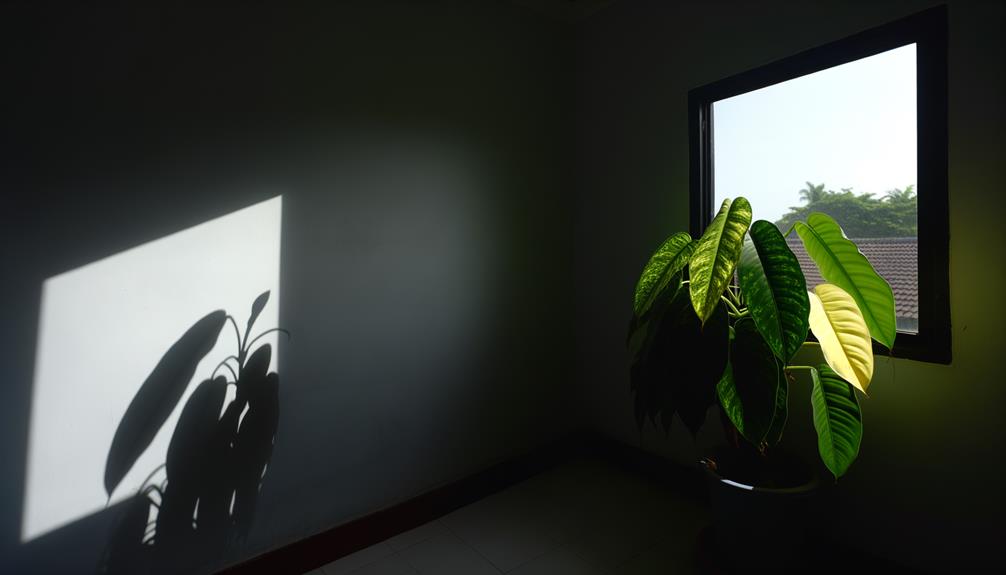
Inadequate lighting conditions can significantly impair the photosynthetic process in Philodendron Birkin, thereby resulting in the development of yellow leaves.
Photosynthesis, the plant's mechanism to convert light energy into chemical energy, is essential for chlorophyll production. In low light, chlorophyll synthesis is impeded, causing chlorosis—characterized by yellowing leaves due to reduced chlorophyll.
Moreover, insufficient light disrupts the plant's energy balance, as the energy generated is not enough to meet metabolic needs. This energy deficit leads to the breakdown of chlorophyll and other cellular components.
Ideal lighting should replicate the plant's natural tropical habitat, providing bright, indirect light for at least six hours per day. Assessing the light intensity and duration can help alleviate yellowing caused by inadequate lighting conditions.
Temperature Stress
Temperature stress can critically affect the health of a Philodendron Birkin, manifesting through yellowing leaves. Maintaining an ideal temperature range of 18-24°C is essential, as exposure to cold drafts can disrupt cellular processes and lead to chlorosis.
Conversely, excessive heat can induce symptoms such as wilting and leaf scorch, further exacerbating the plant's stress response.
Ideal Temperature Range
Maintaining an ideal temperature range between 65°F and 80°F is important for the Philodendron Birkin, as deviations can induce temperature stress, leading to yellowing leaves. This species, native to tropical climates, relies on stable thermal conditions to regulate its physiological processes, including photosynthesis and transpiration.
When exposed to temperatures outside this optimal range, cellular functions can become disrupted. Prolonged exposure to subpar temperatures can impair chlorophyll production, resulting in chlorosis, evidenced by yellowing leaves. Additionally, temperature fluctuations can affect the plant's metabolic rate, exacerbating stress responses.
Ensuring a consistent environment within this range minimizes temperature-induced stress and supports the plant's overall health and essentiality, thereby preventing the manifestation of yellow leaves.
Cold Drafts Impact
Exposure to cold drafts can greatly exacerbate temperature stress in Philodendron Birkin, leading to physiological disruptions that manifest as yellowing leaves. The plant's cellular activities are highly sensitive to abrupt temperature fluctuations.
When exposed to cold drafts, the metabolic processes, including photosynthesis and nutrient uptake, are impaired. This results in chlorosis, a condition where chlorophyll production is hindered, causing the characteristic yellowing.
Factors contributing to cold stress include:
- Proximity to windows or doors: Frequent exposure to external cold air.
- Inadequate insulation: Insufficient protection during colder months.
- Sudden temperature drops: Rapid changes in ambient temperature.
Understanding and mitigating these conditions can help maintain the plant's health, ensuring vibrant and lush foliage.
Heat Stress Symptoms
Conversely, excessive heat can impose significant temperature stress on Philodendron Birkin, manifesting through symptoms such as leaf yellowing, wilting, and browning edges. Prolonged exposure to temperatures above the best range (65-75°F) can exacerbate these symptoms, compromising the plant's physiological functions. High temperatures accelerate transpiration rates, leading to rapid water loss and cellular dehydration. This imbalance disrupts nutrient uptake, causing chlorosis (yellowing) and necrosis (browning). Effective mitigation strategies include maintaining ambient temperatures within the recommended range and ensuring adequate humidity levels to reduce transpiration stress.
| Symptom | Cause | Mitigation Strategy |
|---|---|---|
| Leaf Yellowing | High temperature stress | Regulate ambient temperature |
| Wilting | Accelerated transpiration | Increase humidity |
| Browning Edges | Cellular dehydration | Ensure consistent watering |
Understanding these factors is essential for best plant care.
Nutrient Deficiency
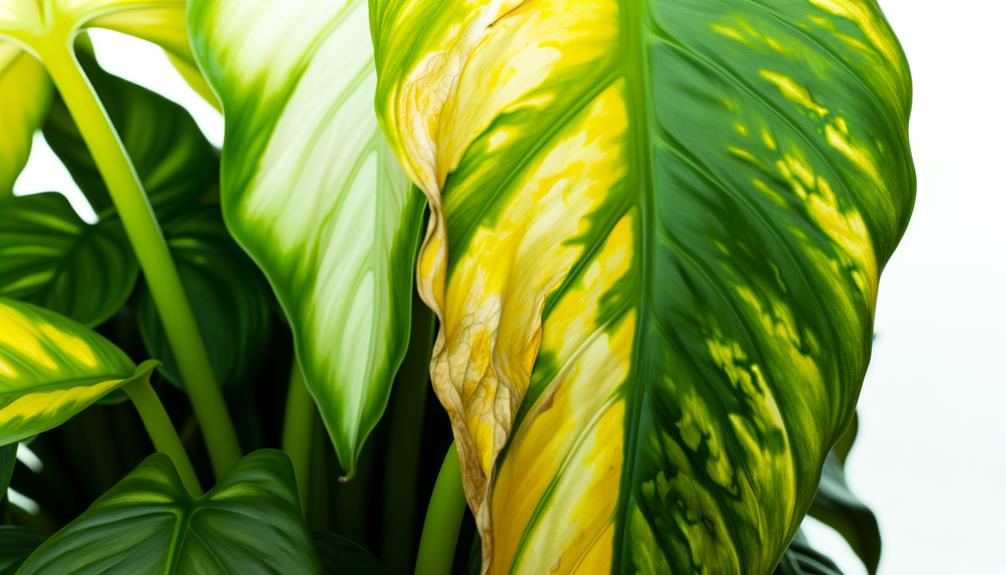
A nutrient deficiency in Philodendron Birkin is often manifested by the yellowing of its leaves, which can indicate a lack of essential macro- and micronutrients such as nitrogen, magnesium, or iron. These deficiencies impede chlorophyll production, essential for photosynthesis, resulting in chlorosis.
Identifying and addressing specific nutrient needs is crucial for plant health. For example:
- Nitrogen Deficiency: Leads to uniform yellowing of older leaves due to impaired chlorophyll synthesis.
- Magnesium Deficiency: Causes interveinal chlorosis, where leaf veins remain green while the tissue between turns yellow.
- Iron Deficiency: Primarily affects new leaves, causing them to yellow while veins remain conspicuously green.
Corrective measures include appropriate fertilization and soil amendments to restore nutrient balance and promote vigorous growth.
Pest Infestation
How do pest infestations contribute to the yellowing of Philodendron Birkin leaves, and what specific pests are most likely to cause this issue?
Pest infestations can disrupt the plant's physiological processes by directly damaging leaf tissue and siphoning off essential sap, leading to chlorosis. Common culprits include spider mites (Tetranychus urticae), aphids (Aphidoidea), and mealybugs (Pseudococcidae).
These pests feed on the plant's sap, impairing nutrient and water transport. The resultant nutrient deficiencies manifest as chlorotic, yellowing leaves. Additionally, pests can introduce pathogenic fungi and bacteria, exacerbating foliar discoloration.
Early detection through meticulous inspection of the undersides of leaves and inter-nodal regions is important for effective pest management and maintaining the plant's vitality and aesthetic appeal.
Natural Aging
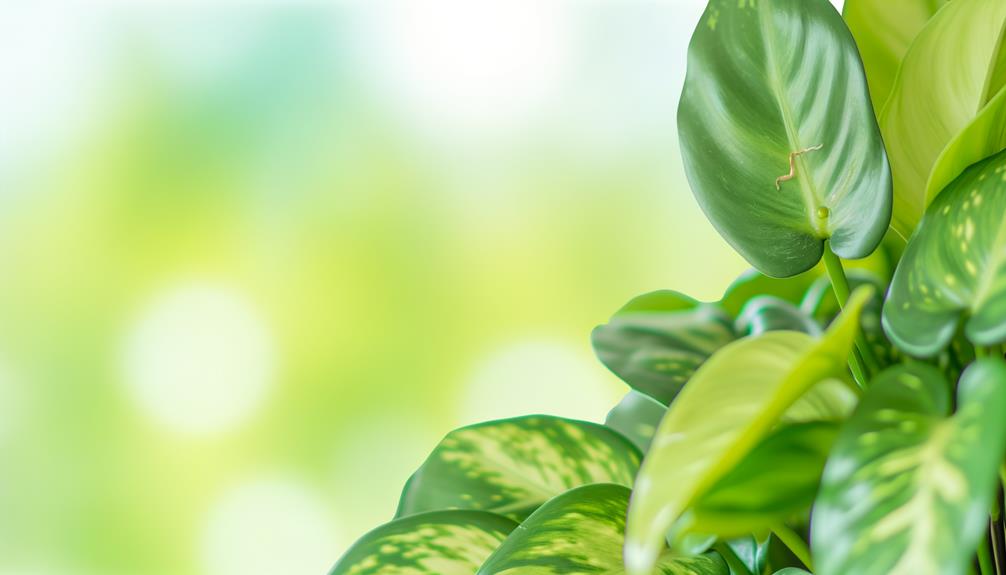
Natural aging in Philodendron Birkin manifests as the gradual yellowing of older leaves, a physiological process that reallocates nutrients and resources to newer growth. This senescence is an integral part of the plant's life cycle, ensuring best possible health and strength. By understanding this natural phenomenon, one can better appreciate the inherent dynamics of their Philodendron Birkin.
- Nutrient Redistribution: Essential minerals and carbohydrates are mobilized from senescent leaves to support emerging foliage.
- Hormonal Regulation: Phytohormones such as ethylene and abscisic acid play a vital role in the programmed cell death of aging leaves.
- Photosynthetic Efficiency: Older leaves often exhibit reduced photosynthetic activity, making their shedding beneficial for the plant's overall energy efficiency.
Recognizing these factors helps in distinguishing natural aging from pathological conditions.
Conclusion
To wrap up, despite the philodendron Birkin's reputation for being a low-maintenance houseplant, it paradoxically harbors a susceptibility to a multitude of environmental stressors. Overwatering, underwatering, inadequate lighting, temperature fluctuations, nutrient deficiencies, pest infestations, and the natural aging process collectively contribute to the manifestation of yellow leaves.
Ironically, the plant's allure and presumed simplicity mask the complexity of its care requirements, necessitating a meticulous approach to horticultural management to maintain its aesthetic appeal and physiological health.

